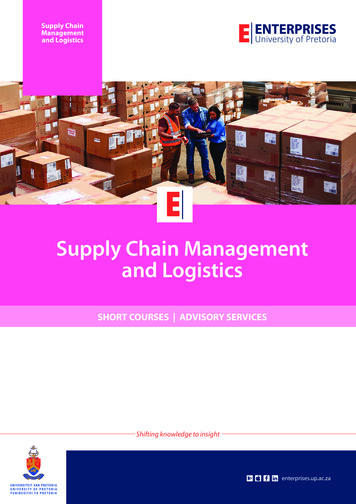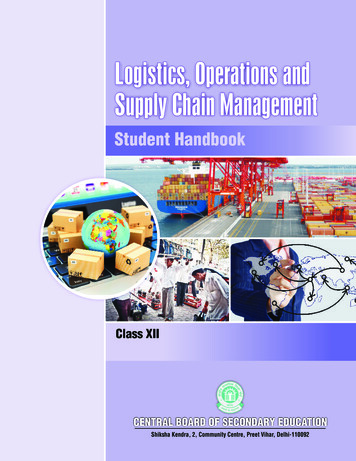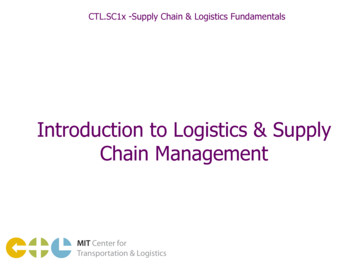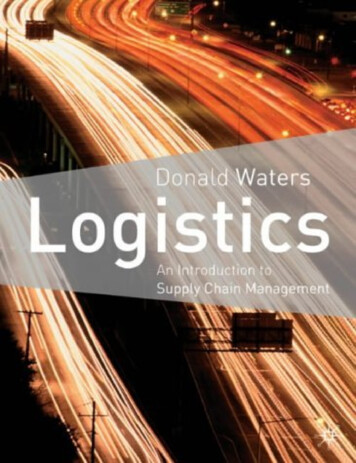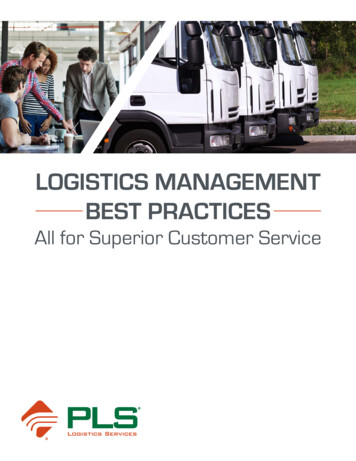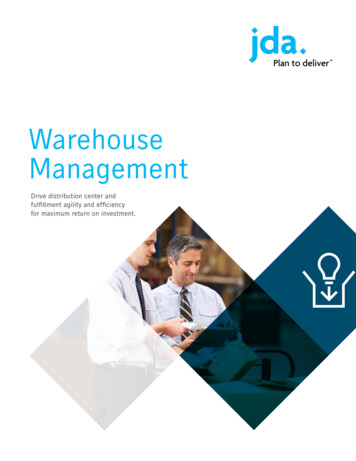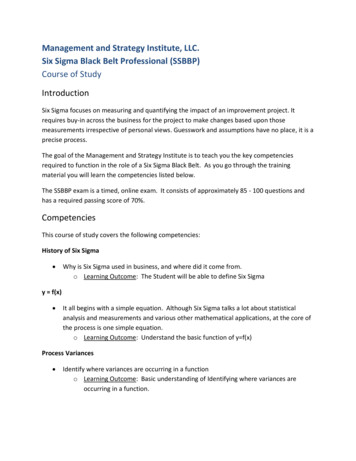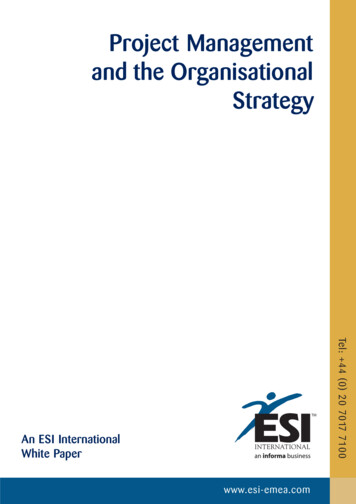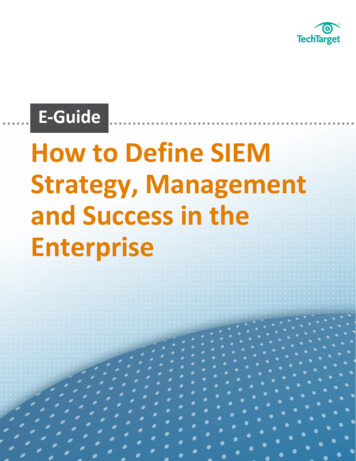
Transcription
Competing through the supply chain3rd editionAlan Harrison and Remko van HoekA concise, applied and strategic introduction to the subject of logistics and supply chain management, perfectfor modern managers and students of logistics and supply chain management.Logistics and supply chain management continue to transform the competitive landscape and have becomeone of today’s key business issues. This third edition of Logistics Management and Strategy continues to take apractical, integrated and international approach to logistics and includes the very latest research to reflect theinnovative and exciting developments in this subject area.A clear framework guides the reader through the four parts of the book, covering:lan introduction to logistics and its contribution to competitiveness and value creation,lleveraging logistics operations within the context of the customer,lsupplier partnerships, interfaces and the challenges of integration,lleading-edge thinking in logistics and the future challenges ahead.Every chapter features case studies with study questions, activities and end of chapter discussion questionsto help students explore logistical concepts in operational detail. Teaching support notes and PowerPointslides for lecturers can be downloaded from the book’s website at www.pearsoned.co.uk/harrison‘Well written and contains a wealth of valuable ideas and concepts.’Dr Jan de Vries, University of Groningen‘Very up-to-date, both in terms of its conceptual framework andthe topics covered. Remarkably clear and easy to read.’Dr Tony Whiteing, University of HuddersfieldAlan Harrison is Professor of Operations and Logistics at Cranfield School of Management, and Director ofResearch at The Cranfield Centre for Logistics and Supply Chain Management.Logistics Managementand StrategyCompeting through the supply chain3rd edition3rdeditionHarrison and van HoekNew to this edition lmore on reverse logistics together with green, ethical and CSR issues,lrevised chapters on supply chain planning and control and on agility,lfully revised final chapter ties in the future challenges facing logistics more closelywith the rest of the book.Logistics Managementand StrategyLogistics Management and StrategyRemko van Hoek is Professor of Supply Chain Management at The Cranfield Centre for Logistics and SupplyChain Management. He is also Vice President Procurement at Nuon in the Netherlands.www.pearson-books.com9780273712763 03 COVER.indd 1Alan Harrison andRemko van Hoek18/10/07 13:56:29
LOGI A01.QXP3/17/089:35 AMPage iLogistics Managementand StrategyCompeting through the supply chain
LOGI A01.QXP3/17/089:35 AMPage iiWe work with leading authors to develop thestrongest educational materials in logistics,bringing cutting-edge thinking and bestlearning practice to a global market.Under a range of well-known imprints, includingFinancial Times Prentice Hall, we craft high quality print andelectronic publications which help readers to understandand apply their content, whether studying or at work.To find out more about the complete range of ourpublishing, please visit us on the World Wide Web at:www.pearsoned.co.uk
LOGI A01.QXP3/17/089:35 AMPage iiiLogistics Managementand StrategyCompeting through the supply chainThird EditionAlan HarrisonRemko van Hoek
LOGI A01.QXP3/17/089:35 AMPage ivPearson Education LimitedEdinburgh GateHarlowEssex CM20 2JEEnglandand Associated Companies throughout the worldVisit us on the World Wide Web at:www.pearsoned.co.ukFirst published 2002Second edition published 2005Third edition published 2008 Pearson Education Limited 2002, 2005 Alan Harrison and Remko van Hoek 2008The rights of Alan Harrison and Remko van Hoek to be identified as authorsof this work have been asserted by them in accordance with the Copyright,Designs and Patents Act 1988.All rights reserved. No part of this publication may be reproduced, stored ina retrieval system, or transmitted in any form or by any means, electronic,mechanical, photocopying, recording or otherwise, without either the priorwritten permission of the publisher or a licence permitting restricted copyingin the United Kingdom issued by the Copyright Licensing Agency Ltd,Saffron House, 6–10 Kirby Street, London EC1N 8TS.All trademarks used herein are the property of their respective owners. The use ofany trademark in this text does not vest in the author or publisher any trademarkownership rights in such trademarks, nor does the use of such trademarks imply anyaffliliation with or endorsement of this book by such owners.ISBN: 978-0-273-71276-3British Library Cataloguing-in-Publication DataA catalogue record for this book is available from the British LibraryLibrary of Congress Cataloging-in-Publication DataHarrison, Alan, 1944–Logistics management and strategy : competing through the supply chain / Alan Harrison,Remko van Hoek.— 3rd ed.p. cm.Includes bibliographical references and index.ISBN-13: 978-0-273-71276-3 (pbk. : alk. paper) 1. Business logistics. 2. Industrialmanagement. I. Hoek, Remko I. van. II. Title.HD38.5.H367 2008658.5—dc22200704644710 9 8 7 6 5 4 3 211 10 09 08Typeset in 9.5pt Stone Sans by 3Printed and bound in MalaysiaThe publisher’s policy is to use paper manufactured from sustainable forests.
LOGI A01.QXP3/17/089:35 AMPage vTo Nick, Katie, Maryl and Ticho, with love.
LOGI A01.QXP3/17/089:35 AMPage vi
LOGI A01.QXP3/17/089:35 AMPage viiContentsForewordPrefaceAuthor’s acknowledgementsPublisher’s acknowledgementsHow to use this bookPlan of the bookxvxviixixxxxxiiixxvPart One COMPETING THROUGH LOGISTICS1 Logistics and the supply chainIntroduction1.1 Logistics and the supply chain1.1.1 Definitions and concepts1.1.2 Supply chain: structure and tiering1.2 Material flow and information flow1.2.1 Material flow1.2.2 Information flow1.3 Competing through logistics1.3.1 Hard objectives1.3.2 Supportive capabilities1.3.3 Soft objectives1.3.4 Order winners and qualifiers1.4 Logistics strategy1.4.1 Defining ‘strategy’1.4.2 Aligning strategies1.4.3 Differentiating strategiesSummaryDiscussion questionsReferencesSuggested further reading2 Putting the end-customer firstIntroduction2.1 The marketing perspective2.1.1 Rising customer expectations2.1.2 The information revolution2.2 Segmentation2.3 Quality of service2.3.1 Customer 3535364445
LOGI A01.QXPviii3/17/089:35 AMPage viiiContents2.3.2 Value disciplines2.3.3 Customer relationship management (CRM)2.3.4 Measuring service quality2.4 Setting priorities for logistics strategy2.4.1 Step 1: Diagnose current approach to market segmentation2.4.2 Step 2a: Understand buying behaviour2.4.3 Step 2b: Customer value analysis2.4.4 Step 3: Measure logistics strategy driver2.4.5 Step 4: Specify future approach to market segmentationSummaryDiscussion questionsReferencesSuggested further reading3 Value and logistics costsIntroduction3.1 Where does value come from?3.1.1 Return on investment (ROI)3.1.2 Financial ratios and ROI drivers3.2 How can logistics costs be represented?3.2.1 Fixed/variable3.2.2 Direct/indirect3.2.3 Engineered/discretionary3.3 Activity-based costing (ABC)3.3.1 ABC example3.3.2 Cost–time profile (CTP)3.4 A balanced measurement portfolio3.4.1 Balanced measures3.4.2 Supply chain management and the balanced scorecard3.4.3 Supply chain financial model3.5 Supply chain operations reference model (SCOR)SummaryDiscussion 66769717176788182838586878889939495Part Two LEVERAGING LOGISTICS OPERATIONS4 Managing logistics internationallyIntroduction4.1 Drivers4.1.14.1.24.1.34.1.4and logistics implications of internationalisationLogistical implications of internationalisationTime-to-marketGlobal consolidationRisk in international logistics9999101102105106109
LOGI A01.QXP3/17/089:35 AMPage ixContents4.2The tendency towards internationalisation4.2.1 Focused factories: from geographical to productsegmentation4.2.2 Centralised inventories4.3 The challenges of international logistics and location4.3.1 Extended lead time of supply4.3.2 Extended and unreliable transit times4.3.3 Multiple consolidation and break points4.3.4 Multiple freight modes and cost options4.3.5 Location analysis4.4 Organising for international logistics4.4.1 Layering and tiering4.4.2 The evolving role of individual plants4.4.3 Reconfiguration processes4.5 Reverse logistics4.6 Managing for risk readiness4.6.1 Immediate risk readiness4.6.2 Structural risk readiness4.7 Corporate social responsibility in the supply chainSummaryDiscussion questionsReferencesSuggested further reading5 Managing the lead-time frontierIntroduction5.1 The role of time in competitive advantage5.1.1 Time-based competition: definition and concepts5.1.2 Time-based initiatives5.1.3 Time-based opportunities to add value5.1.4 Time-based opportunities to reduce cost5.1.5 Limitations to time-based approaches5.2 P:D ratios and differences5.2.1 Using time as a performance measure5.2.2 Using time to measure supply pipeline performance5.2.3 Consequences when P-time is greater than D-time5.3 Time-based process mapping5.3.1 Stage 1: Create a task force5.3.2 Stage 2: Select the process to map5.3.3 Stage 3: Collect data5.3.4 Stage 4: Flow chart the process5.3.5 Stage 5: Distinguish between value-adding andnon-value-adding time5.3.6 Stage 6: Construct the time-based process map5.3.7 Stage 7: Solution 46146147148150153154154155155155156156
LOGI A01.QXPx3/17/089:35 AMPage xContents5.4Managing timeliness in the logistics pipeline5.4.1 Strategies to cope when P-time is greater than D-time5.4.2 Practices to cope when P-time is greater than D-time5.5 A method for implementing time-based practices5.5.1 Step 1: Understand your need to change5.5.2 Step 2: Understand your processes5.5.3 Step 3: Identify unnecessary process steps and largeamounts of wasted time5.5.4 Step 4: Understand the causes of waste5.5.5 Step 5: Change the process5.5.6 Step 6: Review changes5.5.7 Results5.6 When, where and how?SummaryDiscussion questionsReferencesSuggested further reading6 Supply chain planning and controlIntroduction6.1 The supply chain ‘game plan’6.1.1 Planning and control within the focal firm6.1.2 Managing inventory in the supply chain6.1.3 Inter-firm planning and control6.2 Just-in-time (JIT)6.2.1 The just-in-time system6.2.2 JIT and material requirements planning (MRP)6.3 Lean thinking6.3.1 The seven wastes6.3.2 Application of lean thinking to business processes6.3.3 Role of lean practices6.3.4 Design strategies6.3.5 Lean product design6.3.6 Lean facility design6.3.7 Lean thinking summarySummaryDiscussion questionsReferencesSuggested further reading7 The agile supply chainIntroduction7.1 The concept of agility7.1.1 Demand characteristics and supply capabilities7.1.2 Classifying operating 97197197198198199200201203203204206214
LOGI A01.QXP3/17/089:35 AMPage xiContents7.1.3 Preconditions for successful agile practice7.1.4 Summary7.2 Agile drivers and practices7.2.1 Joint decision making to improve external networkintegration7.2.2 Developing measures to put the end-customer first7.2.3 Shared goals to improve virtual integration7.2.4 Boundary-spanning SOP to improve process integrationSummaryDiscussion questionsReferencesSuggested further readingxi214219219222223224225226227228229Part Three WORKING TOGETHER8 Integrating the supply chainIntroduction8.1 Integration in the supply chain8.1.1 Internal integration: function to function8.1.2 Inter-company integration: a manual approach8.1.3 Electronic integration8.2 Efficient consumer response (ECR)8.2.1 Category management8.2.2 Continuous replenishment8.2.3 Enabling technologies8.3 Collaborative planning, forecasting and replenishment (CPFR)8.3.1 Benefits of electronic collaboration8.4 Vendor-managed inventory (VMI)8.4.1 How VMI works8.4.2 Potential benefits8.4.3 Potential problems in setting up a VMI system8.5 Quick response (QR)8.5.1 JIT/QR relationship8.5.2 Role of enabling technologies8.6 Managing supply chain relationships8.6.1 Creating closer relationships8.6.2 Factors in forming supply chain relationshipsSummaryDiscussion questionsReferencesSuggested further reading9 Purchasing and supply 263265265
LOGI A01.QXPxii3/17/089:35 AMPage xiiContents9.19.2Choosing the right supply relationshipsPartnerships in the supply chain9.2.1 Economic justification for partnerships9.2.2 Advantages of partnerships9.2.3 Disadvantages of partnerships9.3 Supply base rationalisation9.3.1 Supplier management9.3.2 Lead suppliers9.4 Supplier networks9.4.1 Supplier associations9.4.2 Japanese keiretsu9.4.3 Italian districts9.5 Supplier development9.5.1 Integrated processes9.5.2 Synchronous production9.6 Implementing strategic partnershipsSummaryDiscussion questionsReferencesSuggested further 85286290291292293Part Four CHANGING THE FUTURE10 Logistics future challenges and opportunitiesIntroduction10.1 Internal alignment10.2 Selecting collaborative opportunities upstream and downstream10.3 Managing with cost-to-serve to support growth and profitability10.4 The supply chain manager of the futureSummaryDiscussion questionsReferencesSuggested further readingIndex297297298302305308310310310310311
LOGI A01.QXP3/17/089:35 AMPage xiiiSupporting resourcesVisit www.pearsoned.co.uk/harrison to find valuable online resourcesFor instructors Complete, downloadable Instructor’s Manual, containing teaching notes,notes on case studies and teaching tips, objectives and discussion points foreach chapter Downloadable PowerPoint slides of all figures from the bookFor more information please contact your local Pearson Education salesrepresentative or
Logistics Management and Strategy Competing through the supply chain 3rd edition Alan Harrison and Remko van Hoek A concise, applied and strategic introduction to the subject of logistics and supply chain management, perfect for modern managers and students of logistics and supply chain management. Logistics and supply chain management continue to transform the competitive
